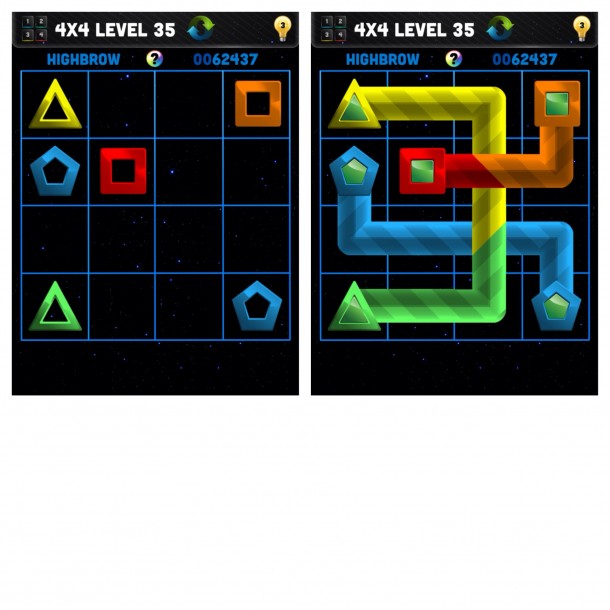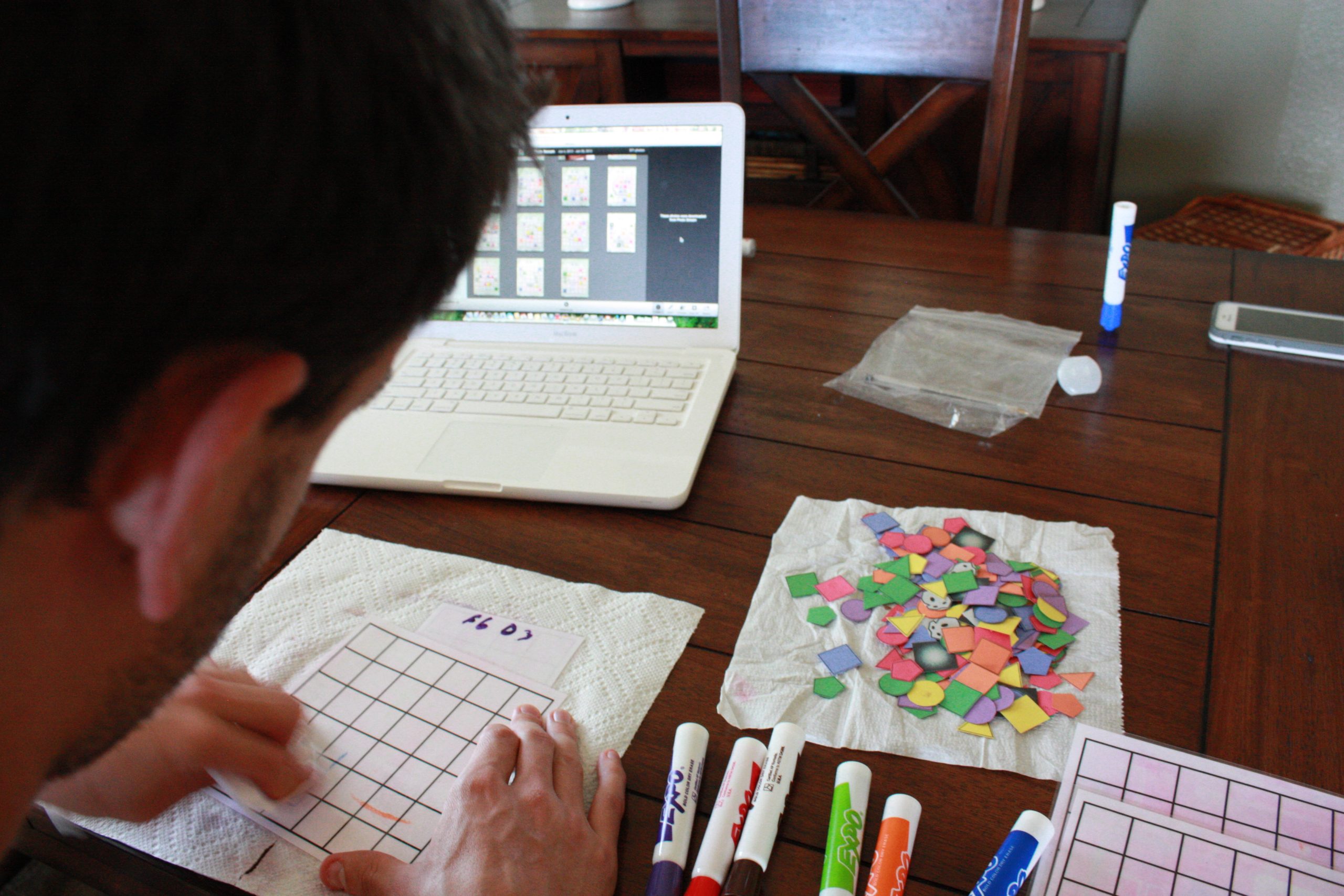Andrew Schiel is many things — husband, father, Marine veteran, Air Traffic Controller — and a creator. The Denver resident came home from work one day a different man than when he left that morning … he had an idea. Over the past 6 months, the self-professed “project-oriented type of guy” could be found sprawled across his living room floor working with a small army of cut-out shapes that would be placed onto a large, laminated paper grid. To many, this would look like the beginnings of some abstract art piece. For Schiel, this has been a project he holds near and dear to his heart — it is a real world layout of his first video game, Flux Free.
I recently sat down with he and his wife, Jen, along with their one-year-old daughter, Gwendolyn, to get acquainted with the iOS puzzle game that’s been frequently compared to the mega-successful Flow, but is, in fact, unique. I’m with Schiel at the climax of the development process, where he and his programmer, Ryan Davis (Zen Develop), are swiftly squashing every bug discovered by their testers. Schiel assures me that by the game’s launch it will be thoroughly bug-free. And I believe him. Over our burgers and fries, he speaks calmly, but confidently, his words chosen thoughtfully and with great enthusiasm. I get the sense that this new flirtation with game development is more than just a casual affair.

Schiel presents an iPad and points to a clever collage of geometric art that is the home screen icon. In the start menu, I’m greeted with a nice, contemplative track, part of a score very much valued by Schiel, who’s quick to credit Dexter Britain (from Britain, as it happens) for the impressive compositions.
I test the water with easy mode, at which Flux is initially played on a 4×4 grid with a background of outer space visuals. It starts with shape-matching — you draw a line from one triangle, for example, to another. But to connect at all, both shapes must be the same color. In basic scenarios, there are two other shapes on the grid, both of which have the same color and can connect. Once those two are united, players must use the line from an unconnected shape and run it through the connected line, which gives you a line of new color, one that will match the other shape, and connect. Schiel is bewildered by my tendency to draw the line diagonally, a move that he’d never seen performed by testers. It’s also an illegal action, as Flux asks for deliberate swipes across the grid, which makes for more orderly gameplay, and also sustains some difficulty, as puzzles would be conquered more simply if players were able to cut around the grid. I navigate obstacles such as asteroids and wormholes, testing my spatial awareness on top of the other mind games Flux throws my way. A ranking system is in place, and each level-up is accompanied by an audible “Oh yeah”, which mirrored my own feelings. Next to the listing of points is a fun fact — did you know that a leech has 32 brains?
Yeah, I had a really good time.

Schiel and I discuss game design and how, when building a game, you’re essentially smithing a key compatible with any door — “key” equaling “game”, and “any door” meaning “any brain.” That can be difficult, to speak to all sorts of people with one game, one game that’s the same for everybody the world over. Game design, like film craft and literary workings, is a language. Recalling all of Flux’s very conscious strokes of design, I’m now awake to Andrew’s ever-consistent, at times sensorial theme of shapeliness, of order, of stern clarity. We’re told in math classes that there’s only one answer to a problem at hand, and Flux takes that “one answer” philosophy to many areas.
A major constituent of Flux’s psychological deviancy is its forcible reintroduction of color theory onto its players. There’s a point in everyone’s life where they know full well what two colors make another when mixed together, but that knowledge certainly escaped the forefront of my own noggin during my time with Flux. At times, you’ll be presented with more than one color to mix your line with, and that can stall your thought process a bit. It’s here that I was assaulted with the kind of dour realization that I didn’t know what color was made when blue and yellow mix. At least, not immediately. The Schiels tell me that the young children who’ve played Flux are unburdened by this brief mental pitfall I’ve had — they’re fresh off of those teachings on color theory.

As I carry on with Flux, the seamless deposition of information and game mechanics is notable, as well as the gradual elevation in difficulty. I ask Schiel how long he can maintain the game’s smooth sail, and his answer is “for over 200 levels.” Indeed, both Schiel and Davis rocked out for 1,000 man hours each. Between the grind of development, the infamous stresses of air traffic control, earning a masters degree, and raising Gwendolyn, Schiel was battered.
“The only way to get extra time to do puzzles and app work was to go to bed later and wake up earlier. I was exhausted,” Schiel says, “…still am.”
Jen Schiel still finds it all hard to believe, but she’s always admired her husband for his unfaltering dedication to his creative endeavors. Andrew recently constructed a nursery for Gwendolyn, and opposing that innocence, also built a kegerator. But even with all that, Jen initially doubted that Andrew would hold on to his game idea, let alone finish it.
“I thought, ‘don’t crush his dreams, Jennifer. Instead, be supportive. This idea will pass,’” she says, “Well, a few days did pass, but the idea didn’t. He was already off in search of a programmer and talking budget with me.”
Before they both knew it, Schiel was on that living room floor, designing levels with those laminated representations of in-game objects. It was there that he made a total of 800 levels, but earlier on in production he had the option not to. Schiel and Davis considered making an algorithm that would generate levels for them, but decided against it, as they felt it was “cheap” and lacked intentionality and a human touch. Additionally, Schiel found that the levels he directly designed where the most well-received among testers, in which he was able to draw the levels out in a symmetrical fashion, and tune it to where players had to perform tricky maneuvers around the grid.

Schiel vies for a certain purity with Flux. His ongoing wish has been for an experience devoid of ads that pester. Banner ads, he believes, is combative to gameplay. And if you’re prone to regard your library of iOS games as virtual products, then Flux shouldn’t disappoint. With the free version you get 200 levels, and players can always jump onto the extra level packs already available. Schiel thinks users will feel positively “fluxed”.
As any creative individual should know, putting your masterpiece out there — whatever it may be — is a major anxiety-inducer. But Schiel can’t stop. He gets a kick out of learning new things, to the point where Jen says she teases him about it. But the stress was still present during development, and once Flux became playable it served as a kind of therapeutic product. Here was a project that came from nothing to something, and to see Flux breathing allowed Schiel to breathe himself.

Cue a couple more months of bug-ridding, a phase that’s easy to ignore over when thinking of the future. Confronted with the here and now, Schiel and Davis would fix one bug, but another would appear, hampering their goal in submitting to Apple at their desired time.
The 14th of November arrived, and Flux was finally submitted to the company. Apple was prompt in their approval process and it was released within 24 hours on the App Store. Some have a tendency to feel naked when they unveil something they’ve put so much of themselves into — art is an extension of oneself. I wonder about the feelings of Schiel. I’d like to meet with him again, and get a good look at the post-launch Andrew Schiel.
In addition to his roles as husband, father, Marine veteran, Air Traffic Controller, and creator, Schiel is a man who loves to learn. I see that with Flux, whether it be moments where the game lays down a fun fact, or when I learn which color mixes with another to solve a puzzle. Flux reminded me that it isn’t “learn we must” but “learn we can”, because that’s so much more fun.
You can download Flux Free here: https://itunes.apple.com/us/app/flux-free/id674918213?mt=8


No Comments